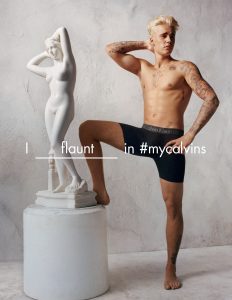
(Vine, 2016)
The Orginal Ad: Pointing Out the Problematic Messaging
In 2016 the fashion brand Calvin Klein came out with a series of ads with the #mycalvins hashtag front and center. Throughout the campaign, they have had a number of celebrities promote their underwear line with the same slogan. In this particular ad, Justin Bieber stands in a stoic pose, with the caption “I flaunt in #mycalvins”. The first issue with the ad is their depiction of masculinity, or rather what masculinity should look like. At first glance Bieber’s pose may just seem as if he is flaunting, demonstrating the ads tag line. But when viewed critically, one can see the subtle reflection of male dominance. He towers over the petite female statue, with his foot propped up on top of it, looking away from the camera. His facial expression gives off an almost unemotional or uninterested impression. Using few words, this ad implies that by wearing Calvin Klein underwear you will be just like Justin Bieber: masculine and dominant.
The second major problem with the ad is its portrayal of body standards. Justin Bieber who is modeling the brand name underwear appears to have six-pack abs, bulging biceps and supposedly no body fat whatsoever. They could have just left it at that, but they took it even one step further. Next to him, they have purposefully included a nude Greek statue of a female. The statue has large hips and a large bust, with a tiny waist. This Calvin Klein ad appears to define unachievable body standards for both males and females, in an ad that is supposed to be selling male underwear. Through this, the utility of the product itself loses meaning, and the emphasis becomes the influence of the brand on self-image.

The Jammed Ad: Subverting the Messaging
In the jammed version of the ad, I have made changes that exaggerate the subtle messages of the original. The first thing I did was take Bieber’s already photoshopped and unrealistic body and further form his body into the unhealthy stereotype of what a male body should look like. I also went ahead and did the exact same thing to the female statue. For a man, society tells us they should be tall, have broad shoulders and a muscular physique. While a woman should maintain an hourglass figure- big breasts, big hips, and a small waist. With 79% of Americans being unhappy with how their body looks (Jackson & Lemay 2018), Calvin Klein is capitalizing on a prevalent vulnerability and presenting their brand as the solution.
The second component of the ad I changed is the slogan. I changed the word “flaunt” to “I want you to really believe that you can look like”. This highlights the obvious purpose of the ad, which is to convince the consumer that buying into their brand will help them to achieve everything they see in front of them in the image. In continuing with highlighting this problematic messaging, I decided to add the Calvin Klein logo as a tattoo on both Bieber and the statue. This is to bring to life the subtle implication that one must literally “brand” themselves in Calvin Klein to look and be a certain way.
Finally, I changed Justin Bieber’s facial expression into a frown. This is to exaggerate Calvin Klein’s messaging of masculinity. In addition to a muscular physique, this is telling the consumer that being masculine isn’t by showing a happy or joyful expression, but rather one that is muted or angry.
Overall, I hope that the over-embellished features in my jammed ad will bring to the forefront the problematic messaging in the original. Which is that by consuming the brand, one will attain the definition of what society deems masculine or feminine.
References
Vine, Richard. “Justin Bieber Flaunts for Calvin Klein: Stylewatch.” The Guardian, Guardian News and Media, 27 Jan. 2016, www.theguardian.com/fashion/2016/jan/27/justin-bieber-flaunts-for-calvin-klein-stylewatch.
Jackson, Chris, and Marie-Pierre Lemay. “Most Americans Experience Feeling Dissatisfied with How Their Body Looks from Time to Time, Including Nearly Two in Five Who Feel This Way Whenever They Look in the Mirror.” Ipsos, Ipsos, 13 Feb. 2018, www.ipsos.com/en-us/news-polls/most-americans-experience-feeling-dissatisfied-with-body-looks-from-time-to-time.